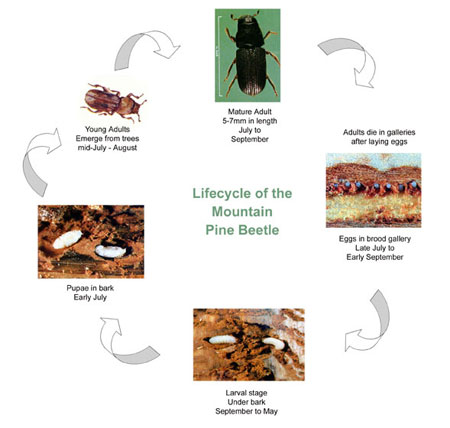|
Beetles and Stress: Changing Local Climate One Tree at a Time By: Melanie Vanderhoof PhD We often hear about the impacts of invasive species on local environments. However, an organism does not need to be invasive or large to have drastic effects at a landscape level. Mountain pine beetle (MPB) outbreaks in the south central Rocky Mountains exemplify the far-reaching effects that one small native species may have on entire ecosystems. Dr. Melanie Vanderhoof, currently an ORISE post-doctoral research fellow at the Environmental Protection Agency, investigated the impacts of these outbreaks on long-term energy and water fluxes in coniferous forests in Colorado and Wyoming. These variations to climate patterns can last for more than 40 years and coupled with global climate change, the dynamics of these outbreaks may also be altered. Cresting a mountain pass almost anywhere in Colorado or Wyoming you will see an alarming number of dead and dying pine trees in the valleys below. During the last couple of decades over 42 million acres of green forest have turned into red/gray timberland due to the MPB epidemic. Although boom-bust cycles for the MPB are common, the scope of the current outbreak is one of the largest and most severe in history. The MPB epidemic began in the mid-1990s on ponderosa pines at lower elevations along the Rocky Mountain Front Range. By 2004 the MPB shifted to lodgepole pines, which live at higher elevations. The peak of the outbreak was in 2007 followed by a decline in newly infected trees. During non-epidemic years the MPB is typically unable to kill healthy trees. However, recent winters in the Rocky Mountains have been warmer while summers have been both warmer and dryer. These changes in climate increased stress on evergreen trees and left them vulnerable to MPB attack. Female adult beetles carrying blue fungus stain channel under the bark of a healthy, but stressed, tree. The fungus from the MPB blocks the transport of water and nutrients within the tree and prevents the tree’s defense against the beetle invaders. The beetles mate, lay eggs, and when the eggs hatch, the MPB larvae burrow further into the tree. The MPB pupates, and the young adults continue to feed in the tree, becoming contaminated by the blue stain fungus. The contaminated adults then leave the tree and infect a new tree close by. The life cycle of the MPB is generally one year, but may be up to two years in high elevation environments. Given the dynamics of these outbreaks, Dr. Vanderhoof examined seasonal changes in albedo and evapotranspiration over time. On a shorter time scale, the peak in albedo seemed to be around 10 years in winter—think of all the snow now visible from above and reflecting light—before regeneration took off in these forests. However, when she examined the changes on a decadal scale, she found that increases in albedo lasted for 30 years, resulting in peaks in radiative cooling 14-20 years after the outbreaks that were especially high in moderately to highly impacted forests. Evapotranspiration showed decreases in summer around 14-20 years with a corresponding increase in winter, and a second peak with an increase in summer around 30-40 years with a corresponding decrease in winter. These data correspond to the loss of trees that used to participate in the water cycle in summer and higher evaporation/sublimation from exposed snow in the first peak and the peak in stand density which occurs in intermediate aged stands in the second peak. While these forests do experience natural disturbances such as mountain pine beetle outbreaks, the large impacts to water and energy fluxes can cause feedbacks within the systems and may alter forest community composition due to the changes in local climate. Global climate change may also influence the way these outbreaks occur in the future. Outbreaks are becoming more severe as the trees experience greater stress due to drought driven by climate change. With more severe outbreaks, greater influences on local climate through changes to water and energy fluxes may occur. These local fluxes may in turn impact the larger scale. While it’s impossible to know how these dynamics could change in the future, by understanding the large landscape impacts the outbreaks are already having on energy and water, we can begin to draw conclusions about what the future may hold.
If you are interested in reading more about Dr. Vanderhoof’s work, the links to two of her papers are below, and be on the lookout for a third that is in press! Vanderhoof, M., C.A. Williams, B. Ghimire, & J. Rogan. 2013. Impact of mountain pine beetle outbreaks on forest albedo and radiative forcing, as derived from Moderate Resolution Imaging Spectroradiometer, Rocky Mountains, USA. Journal of Geophysical Research: Biogeosciences 118: 1461-1471. Vanderhoof, M., C.A. Williams, Y. Shuai, D. Jarvis, D. Kulakowski, & J. Masek. 2014. Albedo-induced radiative forcing from mountain pine beetle outbreaks in forests, south-central Rocky Mountains: magnitude, persistence, and relation to outbreak severity. Biogeosciences 11: 563-575. Vanderhoof, M. & C.A. Williams. In press. Persistence of MODIS evapotranspiration impacts from mountain pine beetle outbreaks in lodgepole pine forests, south-central Rocky Mountains. Agricultural and Forest Meteorology. Comments are closed.
|
Categories
All
Archives
June 2024
|
Department of Entomology
University of Maryland
4112 Plant Sciences Building
College Park, MD 20742-4454
USA
Telephone: 301.405.3911
Fax: 301.314.9290
University of Maryland
4112 Plant Sciences Building
College Park, MD 20742-4454
USA
Telephone: 301.405.3911
Fax: 301.314.9290




 RSS Feed
RSS Feed




